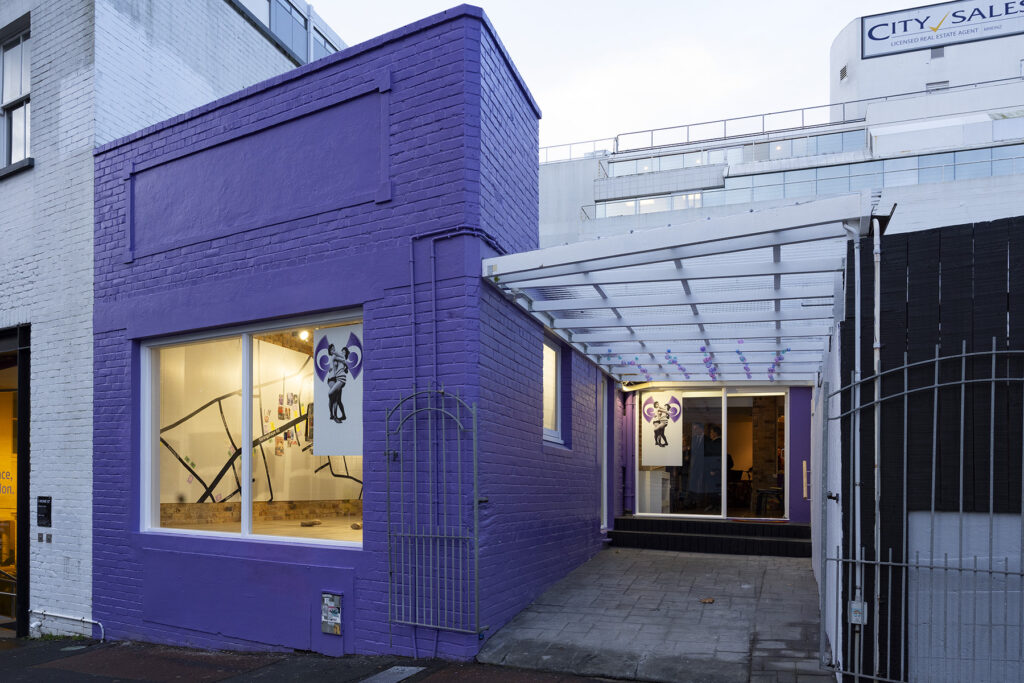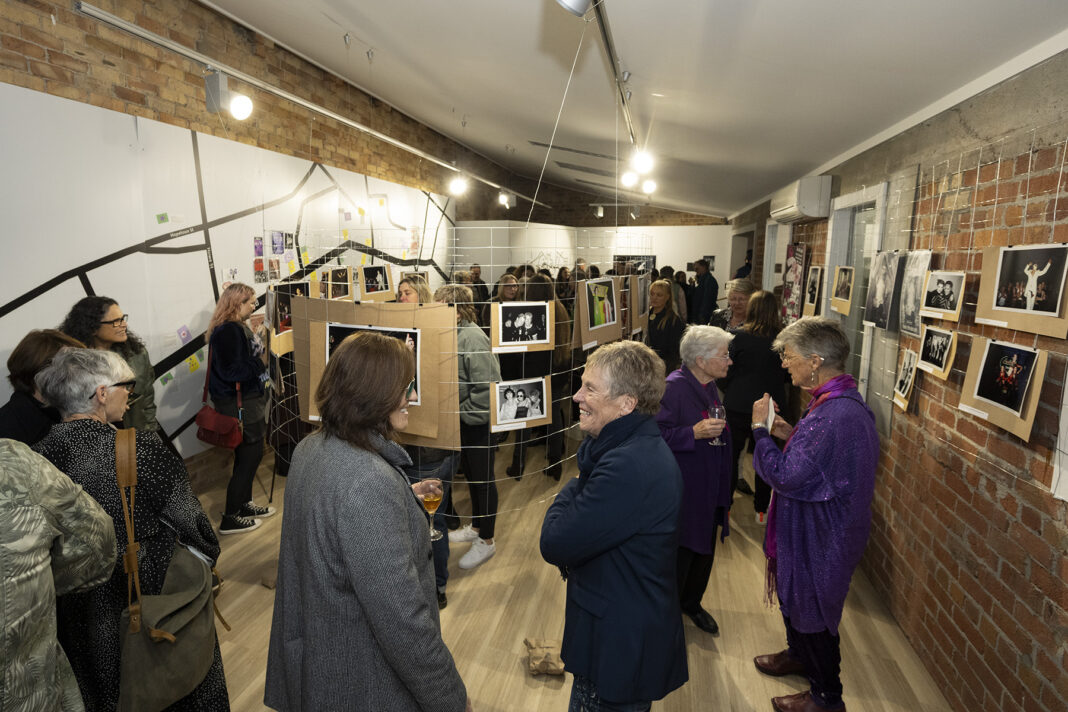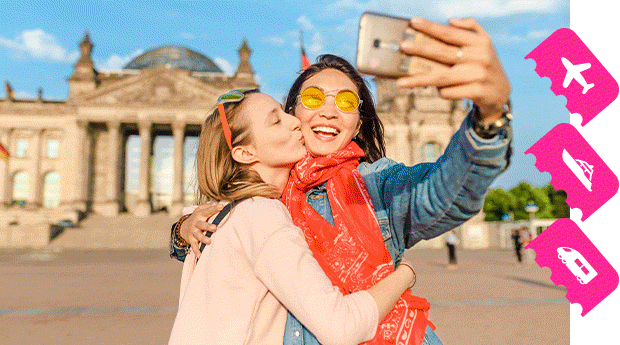Karangahape Road in Auckland, New Zealand, commonly known as K’ Road, has a long, queer history. In the 1970s, it was home to one of the country’s first lesbian nightclubs, as well as several gay clubs in the ’80s and ’90s. It’s something of a main commercial drag for the downtown gaybourhoods of Grey Lynn and Ponsonby.
And as of June 2023, it’s also home to the world’s only independent lesbian museum, The Charlotte Museum. The landlord painted the cute little building, located just off K’ Road at 1A Howe Street, purple to celebrate the institution’s arrival.

“It is quite a significant area historically but, funnily enough, it’s still very queer. Within, say, 200 or 300 metres of us, there are at least five other queer places,” museum coordinator Sarah Buxton tells Pink Ticket. (We found more—see listings below.)
The idea for the volunteer-run museum started to grow in the early 2000s when a group of Auckland queer women started an archive project, working together to collect and document stories about their community. They were sending some of this material to the Lesbian and Gay Archives of New Zealand in Wellington, the country’s capital. But when one of the women tried to get the archives to take a badge collection and a T-shirt she’d made out of a bedspread, the archive declined. Like many archives, they didn’t take objects like textiles, partly because they’re more difficult to maintain and manage than books and other printed matter.

But anyone who knows lesbian culture knows the importance of badges: those sometimes witty political statements that are cheap and easy to make, that can be worn at an event and then taken off if they might inadvertently out the wearer. To lose them would be to lose a significant part of queer history.
The Charlotte Museum Trust was founded in 2007 and the museum opened the doors of its first premise in 2008. The museum’s home for a while was in an rundown industrial area in one of Auckland’s outer suburbs—not a place that a curious traveller would want to visit. So when they found a cute place for lease just off K’ Road, the team moved quickly. “It’s a much more accessible area, accessible through public transportation. People can just walk in,” says Buxton. “It’s such a lively neighbourhood, there’s always action, things happening. We’re right in the middle of a hub of queer activity.”
Since the move they’re getting as many visitors a day as they were getting each month at the old place, even in their first month. The collection includes as many as 7,000 publications in the research library, 400 pieces of art, 600 badges and 400 T-shirts. There’s a personal collection of about 25 lighters with images of women on them. Although there is not a specific collection of Indigenous Māori items, there are a number of pieces by Māori women in the art collection.
Buxton’s favourite objects—at the time we talked, anyway—are two batons. They’re clear glass with a rainbow pattern inside, each one with half of the woman symbol inside. When you put them together, it creates the full woman symbol.

“They were actually used for a protest walk relay in around 1992,” she says. “One baton started at the bottom of the South Island, the other started at the top of the North Island. Groups of women walked from each spot, passing the baton on to the next group of women, protesting women’s rights, pay equity, abortion rights. When they arrived in Wellington, which is conveniently located in the middle of the country, they brought the batons together. And from the warmth of people’s hands, they got a nice little bow to them. I really love those batons because it tells a story of protest and activism, and how the artwork changed shape from the warmth of women’s hands.”
Now that it’s in the queerest part of New Zealand’s largest city (Auckland has a population of about 1.4-million people, making it the fifth largest city in Oceania), the Charlotte Museum is fully tapped into a bustling LGBTQ+ community. Here are a few places to see—or at least be aware of—in the neighbourhood.
Auckland for lesbians and their friends
Parallel (Unit D/501 Karangahape Rd., Auckland CBD). This bookshop and coffee shop, founded by former Seattleites Luna and Jess, is dedicated to uplifting “LGBTQIA+/queer, neurodivergent, Indigenous, disabled and Aotearoa New Zealand voices that have too long gone unnoticed and unheard.”
The Women’s Bookshop (105 Ponsonby Rd., Ponsonby, Auckland). Founded in 1989, this reader’s delight and community hub has a large LGBTQ+ section and hosts regular events.
Rainbow Youth (10 Abbey St., Auckland CBD). Though perhaps of less interest to visitors, it’s worth knowing that this inclusive space hosts social groups for various demographics of young people, as well as year-round events.
Your Ex (offices at Brown St., Auckland CBD). Not for dropping by, but for reading to get up-to-date on what to do and where to go in New Zealand’s metropolis. Formerly known as Gay Express, this is the longest-running and only national LGBTQ+ magazine and media in the country.
Caluzzi Cabaret (461 Karangahape Rd., Auckland CBD). Founded in 1998, this legendary drag-queen dinner theatre has birthed Anita Wigl’it, of Canada’s Drag Race: Canada vs. the World fame, and Kita Mean, who won the first season of RuPaul’s Drag Race Down Under. In fact, the duo bought the place in 2017. It might be called Oceania’s drag powerhouse.
G.A.Y. Auckland (262 Karangahape Rd., Auckland CBD). With drag shows and dancing every Friday and Saturday, this long-standing club caters to the whole LGBTQ+ community.
Family Bar and Club (270 Karangahape Rd., Auckland CBD). Drag shows on Friday and Saturday nights, themed evenings other nights. Two dance floors. High percentage of women patrons on some nights.
A little further afield: Garnet Station (85 Garnet Rd, Westmere, Auckland). About a 40-minute walk away from K’ Road is this pizzeria-art-gallery-theatre, run by artist-performer Verity George and artist Lisa Prager, a couple since 1995. Total lesbian institution.


